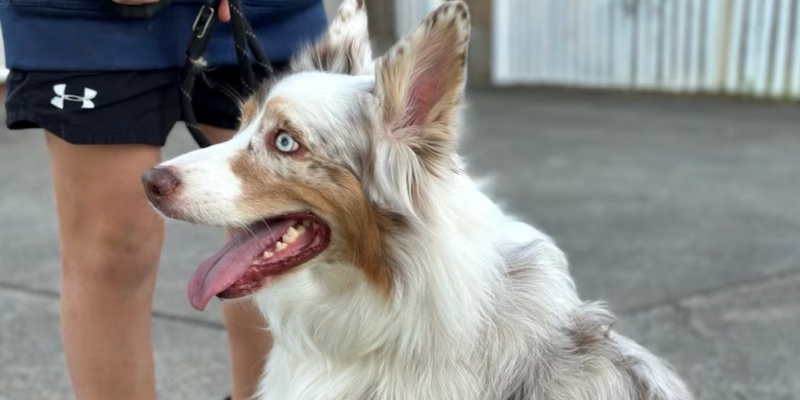| |
|
|
| |
Mira Mar Veterinary Hospital
|
|
| |
|
|
| |
|
|
| |
|
|
|
|

|
| |
September newsletter from Mira Mar Vets
|
|
| |
|
|
| |
Welcome to Spring!
Spring can be a time of year that we start to see skin issues in our pets - fleas are emerging, flowers are blooming, pollens are being released into the air - and all of these can cause havoc in a pet with sensitive skin!
Luckily our newsletter for September is full of great advice to help those pets with sensitive skin, sore eyes, itchy ears or other allergic conditions.
We hope you enjoy reading it! |
|
|
|

|
| |
August Puppy Preschool Class!
|
|
| |
|
|
| |
Look at these little cuties!
Our August Puppy Preschool class got to enjoy the fine winter weather and have some fun in our enclosed back yard!
Congratulations to Buddy, Finn, Jarrah, Lucy, Maverick and Stella on learning good manners and meeting new friends!
If you have a puppy that you think would like to do the same, please call the clinic on 98415422 to find out more. |
|
| |
|
|
| |
CALL NOW!
|
|
|
|

|
| |
“Atopy” …A-what-py?
|
|
| |
|
|
| |
Pets with atopy have a naturally defective skin barrier, meaning that exposure to particular allergens (particles such as pollen, grass or mould) causes their skin or ears to become inflamed and itchy, making them more likely to develop secondary bacterial or yeast infections.
If your pet has been diagnosed with atopy, rest assured. You can do a lot to control their symptom flare-ups and help them live comfortably and happily!
How you can help to control atopy symptoms in your pet
1. Cool baths
Bathing will remove allergens from your pet’s skin, and cool water can help to soothe irritation. Following any bath with a pet-safe skin conditioning product is important to help moisturise the skin and repair the defective barrier.
2. Keeping up with flea and tick prevention
Whilst parasites are not the root cause of an atopic pet’s problem, it’s crucial to prevent any irritation of your pet’s skin where possible, as excess scratching or licking could lead to secondary infection.
3. Essential fatty acid supplementation
Essential fatty acids such as fish oil supplements can help support your pet’s skin barrier and naturally reduce inflammation. Our vets can advise you on a safe and effective dose for your pet.
4. Medicated shampoos
Use a medicated shampoo once or twice weekly to treat and control the bacterial and yeast overgrowth atopic pets are prone to.
How we can help to control atopy symptoms in pets
Depending on the severity of your pet’s symptoms, our vets may discuss oral, injectable, or topical anti-inflammatory or anti-itch products. Your pet may require this treatment year-round or seasonally, depending on what triggers their allergic reaction.
In some cases, our vets may also be able to refer your pet to a specialist dermatologist vet for long-term desensitising immunotherapy (allergy vaccines), which can permanently improve your pet’s allergies.
If you’re itching for more information about pet allergies, consult our knowledgeable veterinary team. |
|
|
|

|
| |
A sight for sore eyes
|
|
| |
|
|
| |
Like us, dogs may suffer from uncomfortable conjunctivitis. Sometimes conjunctivitis develops because of irritants blowing into the eye (such as sand or dust) or eye infections. However, if your pet develops conjunctivitis repeatedly, their problem may have an allergic basis.
Here are the top five things that owners should know about allergic conjunctivitis in dogs:
1. Conjunctivitis involves inflammation of the conjunctiva, the pink tissue that lines the inner eyelids and covers the eyeball.
2. Allergic conjunctivitis usually affects both eyes and leads to symptoms such as eye redness, abnormal eye discharge (which may be watery or thick and yellow to green in colour), squinting and light sensitivity, or itchiness around the eyes or face.
3. Pets with allergic conjunctivitis commonly suffer from other types of allergies, too, such as:
- Atopy: allergies to airborne pollens, dust mites or moulds
- Food allergies
4. Vets commonly treat allergic conjunctivitis with steroid eye ointment or drops to reduce inflammation. Sometimes a pet may also require antibacterial eye medication, especially if they have rubbed at their eye and introduced a secondary infection.
Did you know: Before prescribing steroids to your pet, our vets must perform a fluorescein dye test to check for any ulcers or scratches on your pet’s eye (as steroids can delay the healing of eye injuries and potentially worsen the issue).
5. At home, you can help control your pet’s symptoms by flushing their eyes once or twice daily with sterile saline – this will help to remove any debris or discharge from their eyes and usually feels quite soothing. Our vets may also discuss a trial of antihistamines to see if this helps control your pet’s issues.
So, if your pet develops red, irritated, or mucky eyes, our vets should assess and treat them promptly. We’ll have them feeling better in the blink of an eye! |
|
|
|

|
| |
Four facts about fleas!
|
|
| |
|
|
| |
For some cats, fleas can be more than just an irritation. Here are four facts about fleas and why having a solid, year-round parasite prevention routine for your feline friend is a good idea.
1. You may not see fleas, even if they’re there!
It can be challenging to spot fleas on your pet, as in many cases, cats will vigorously groom themselves to remove fleas from their fur.
With heavier infestations, you may see signs of flea dirt (flea poo), which appears as black granular specks deep within your pet’s fur.
2. Some pets are allergic to flea bites
Whilst some cats with fleas may show minimal symptoms, other pets can develop significant skin problems due to a hypersensitivity reaction (allergy) to flea saliva, known as flea allergy dermatitis.
Cats with flea allergy dermatitis may show symptoms such as:
- Overgrooming (which may lead to bald patches), particularly around the lower back, belly or hindlimbs
- Itchy red bumps or scabs (particularly around their head and neck)
- Inflamed, painful allergic lesions in their mouth (known as eosinophilic granulomas) or on their lips (known as rodent ulcers)
3. Most fleas are in the environment, not on your pet
Any fleas seen on your pet usually represent only a tiny portion of the flea numbers within your pet’s home environment. Adult fleas lay eggs in your pet’s fur, then fall onto the ground and lie dormant for months, waiting for sufficiently warm, humid conditions to hatch. In a warm house, fleas can hatch and multiply year-round.
4. Fleas can cause other health issues
In addition to skin irritation, heavy flea infestations can also cause anaemia, particularly in very young or old pets, leading to symptoms such as lethargy, weakness and pale gums.
Fleas can also spread other infections, such as tapeworms.
If you notice any skin problems in your cat, book a prompt appointment with one of our soothing veterinarians! |
|
|
|

|
| |
Had an earful of infections?
|
|
| |
|
|
| |
Whilst any dog can potentially suffer from an ear infection, some pets are unlucky enough to experience ear troubles throughout their life.
Here’s why some pets develop ongoing ear infections and why prompt treatment is best:
Why are some pets prone to ear infections?
Certain dogs can be more likely to develop ear infections repeatedly, due to:
- Underlying allergies
- Having ears that are prone to trapping wax or moisture, such as:
- Narrow ear canals in shar peis
- Hairy ears in poodles and schnauzers
- Floppy ears in spaniels
- Having insufficient treatment for an ear infection, e.g. premature discontinuation of ear medications without a veterinary check to confirm the infection has resolved
- Frequent water activities leading to moist ear canals
What are the potential complications of leaving ear infections untreated?
Unfortunately, when a dog experiences recurrent or ongoing untreated ear issues, it can cause thickening and narrowing of their ear canals. Once the ear canal thickens, effectively cleaning the ears or administering topical medications becomes more difficult.
Dogs who vigorously shake their heads or paw at their ears may also develop an aural haematoma when a blood vessel within the ear flap bursts, causing it to fill with blood. The swollen ear flap is uncomfortable for the pet. It can scar and shrivel without proper veterinary treatment, causing a permanent change in ear shape.
As well as long-term pain, untreated ear infections may also progress to middle ear disease, which can cause nerve damage, resulting in:
- Vestibular disease, where the pet loses its sense of balance (similar to vertigo)
- Facial paralysis on one side of the face
So, if your pet suffers from recurrent ear infections, book an appointment with our ear-experienced veterinary team to get it sorted promptly! Hear hear! |
|
|
|

|
| |
Let's help your asthmatic cat to breathe easy again
|
|
| |
|
|
| |
Unfortunately, up to 5% of cats may risk developing feline asthma, otherwise known as feline allergic bronchitis.
What is feline asthma?
Feline asthma is a chronic (long-term) condition that causes inflammation and narrowing of the airways within the lungs, leading to reduced airflow and breathing difficulties in the affected pet. These symptoms may worsen suddenly and severely if triggered by an allergic response or a stressful event.
What causes feline asthma?
Feline asthma is caused by allergies to certain airborne irritants, such as:
- pollens
- dust
- cigarette smoke
- mould
- household chemicals
However, cats with asthma can also have flare-ups of their symptoms caused by experiencing stress.
What symptoms do asthmatic cats show?
Here's what to monitor your feline friend for:
Sudden respiratory distress (an inability to breathe correctly)
And long-term symptoms such as:
- coughing
- wheezing
- abnormal lung sounds
- increased breathing rate or effort
How is feline asthma diagnosed?
Feline asthma can often be diagnosed with chest X-rays performed under sedation or anaesthesia. However, some cats may require further testing for diagnosis, such as laboratory testing of airway secretions.
How can feline asthma be treated and managed?
In sudden cases of respiratory distress, cats often require urgent veterinary care for oxygen therapy and medications to reduce their airway spasms and inflammation.
Long-term management usually involves initial oral steroid medication to settle airway inflammation, which may be switched (in cooperative cats!) to a steroid puffer for ongoing maintenance with fewer adverse side effects. Some cats may require a second puffer to relieve airway spasming if they are experiencing a symptom flare-up.
At home, owners can help reduce triggers for their pets by:
- frequently vacuuming
- using dust-free kitty litter
- refraining from smoking within the house
- using a HEPA filter (to remove harmful particles from the air).
Don't hold your breath – consult our veterinary team today about diagnosing and managing pet airway diseases! |
|
|
|

|
| |
Animal News In Brief
|
|
| |
|
|
| |
"More olive oil!" - a tight squeeze for Bonnie
Bonnie the dog was successfully rescued from a precarious situation with the help of "lots of olive oil and patience”, by a team of local heroes outside Cairns, Northern Queensland. Curious Bonnie had managed to get her head stuck in the small, round centre bore of a wheel rim while playing on a property, and crews from Queensland's Mareeba Fire and Rescue, along with a local vet and a vet nurse from Sundance Veterinary Services, teamed up to help Bonnie out of her, well, sticky situation.
The Mareeba Fire and Rescue took to social media to share news of the successful rescue, posting a group picture with Bonnie, her owner, and a great pun “This pup got herself stuck in a wheely difficult position, but luckily no job is too tyre-some for our crews.” The heartwarming story garnered significant attention on social media, with many praising the rural fire department and vet team for their dedication and successful rescue.
Visit 9News to see the Mareeba Fire and Rescue’s photographs of Bonnie’s sticky situation.
Suspected kidnapped dog successfully rescued
Good news for Bowie, the beloved blind Australian Shepherd. Bowie was allegedly stolen during a break in at the Durman family's residence while they were away on a ski trip. When the family returned, Bowie, along with the Durman’s car and certain personal belongings, was nowhere to be seen.
Luke Durman, Bowie’s owner, stated, "Once we realised Bowie was gone, the cars and everything was immaterial to that. The focus was, we just wanted Bowie back." The family noticed that Bowie's belongings, including collars, had disappeared after the break-in, leading them to believe he was stolen rather than wandering off. CCTV footage from their home added to their certainty that someone had taken Bowie deliberately.
Despite disappearing under suspicious circumstances, Bowie was found safe and well. Police tracked him near Nambucca Heads, around 300 kilometres away from his home, after he was spotted by CCTV, sitting in the back of a (stolen) car, while a 48-year-old man suspected of his kidnapping, refuelled at a petrol station on the border of QLD and NSW. Police intercepted the car, and the man has since been arrested in connection with the break-in.
Read the Daily Mail’s coverage of the break in and suspected kidnapping.
Psychology to remember: pets vs. people
Pets should be treated with love and care while respecting their individual needs and nature, but treating pets like children can lead to harm, according to dog behaviourist Faith Wild.
Experts have noted that during COVID lockdowns, close bonds with pets have become more pronounced, and while it can be good fun to narrate a pet’s inner monologue out loud, as responsible owners it’s important not to project human emotions onto pets. “[Dogs] will go to the person who commands respect," said Ms. Wild. According to Ms Wild, pets have different needs than children and require clear boundaries. "If we don't understand the needs of our animals and give them boundaries it can create a lot of confusion," she said.
Ms Wild recommends educating dogs through understanding and trust, avoiding physical punishment, and communicating in the pets' language. Creating rules and consistently correcting mistakes help dogs learn appropriate behaviour. "You don't have to browbeat them or be nasty, but you do have to draw a line where the rules are. And [when] you correct the dog every time they make a mistake, it becomes a habit and they learn not to make that mistake." she said.
Click here to read the ABC’s full article on healthy boundaries between pets and owners |
|
|
|

|
| |
Where are all of our animal icons?
|
|
| |
|
|
| |
Australia is facing an extinction crisis due to events like droughts, floods, bushfires, and habitat destruction.
The iconic platypus, once a common sight, has all but disappeared from Sydney's riverbanks, and their numbers have declined across the country. The blue-tongue lizard, once seen ambling through many an Aussie backyard, is now rarer due to urban sprawl and habitat destruction. The Christmas beetles that decked pavements and verandas with glittering green-red holiday cheer are a rarer sight now, possibly due to climate change and habitat loss. Bogong moths, which used to black out the moon during migration, experienced a population crash of up to 99% due to drought and flooding. Even koalas are labelled vulnerable and are now endangered, with fewer than 58,000 remaining in the wild.
In fact, "Australia is leading the way with one of the worst extinction rates on earth. Our threatened species list is approaching 2000 with new plants and animals being added regularly,” says Australian Conservation Foundation (ACF) nature campaigner Peta Bulling. With the threat of extinction rising, wildlife warriors and conservationists continue to urge everyday Australians to take grassroots action to preserve our unique wildlife.
For more details, read the full article at 9News. |
|
|
|
| |
This email contains comments of a general nature only and is not intended to be a substitute for professional veterinary advice. It should not be relied on as the basis for whether you do or don't do anything.
All content © PetPack 2023 |
|
|
|
[Footer]
|